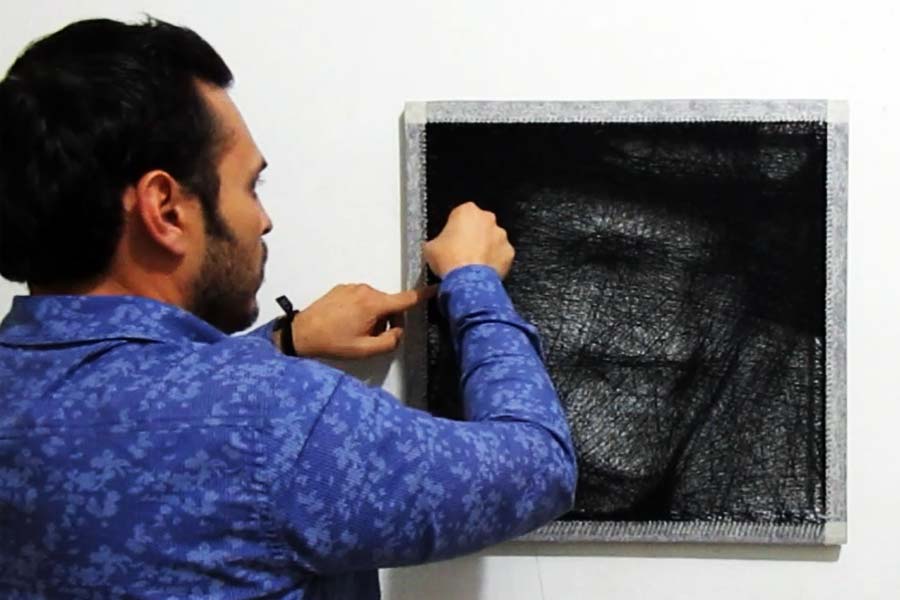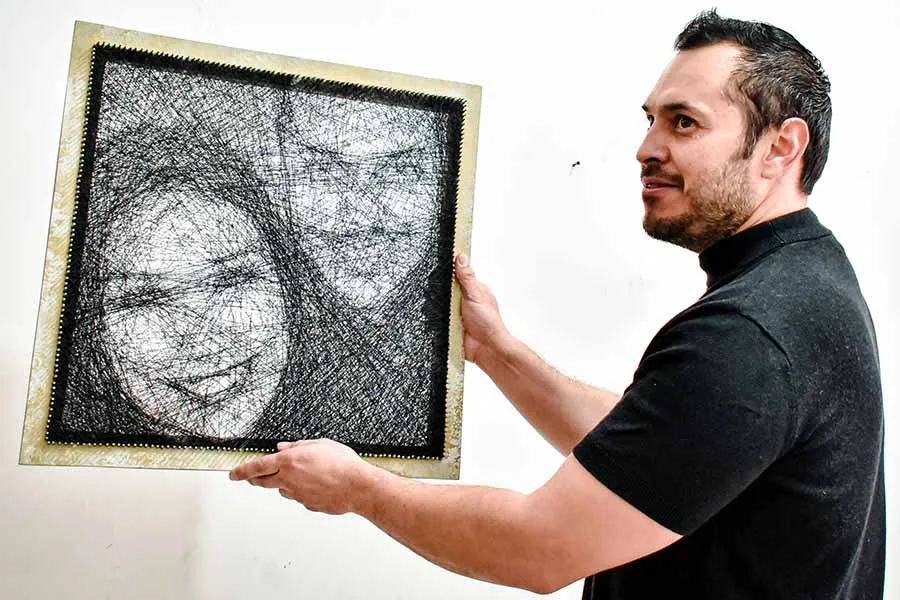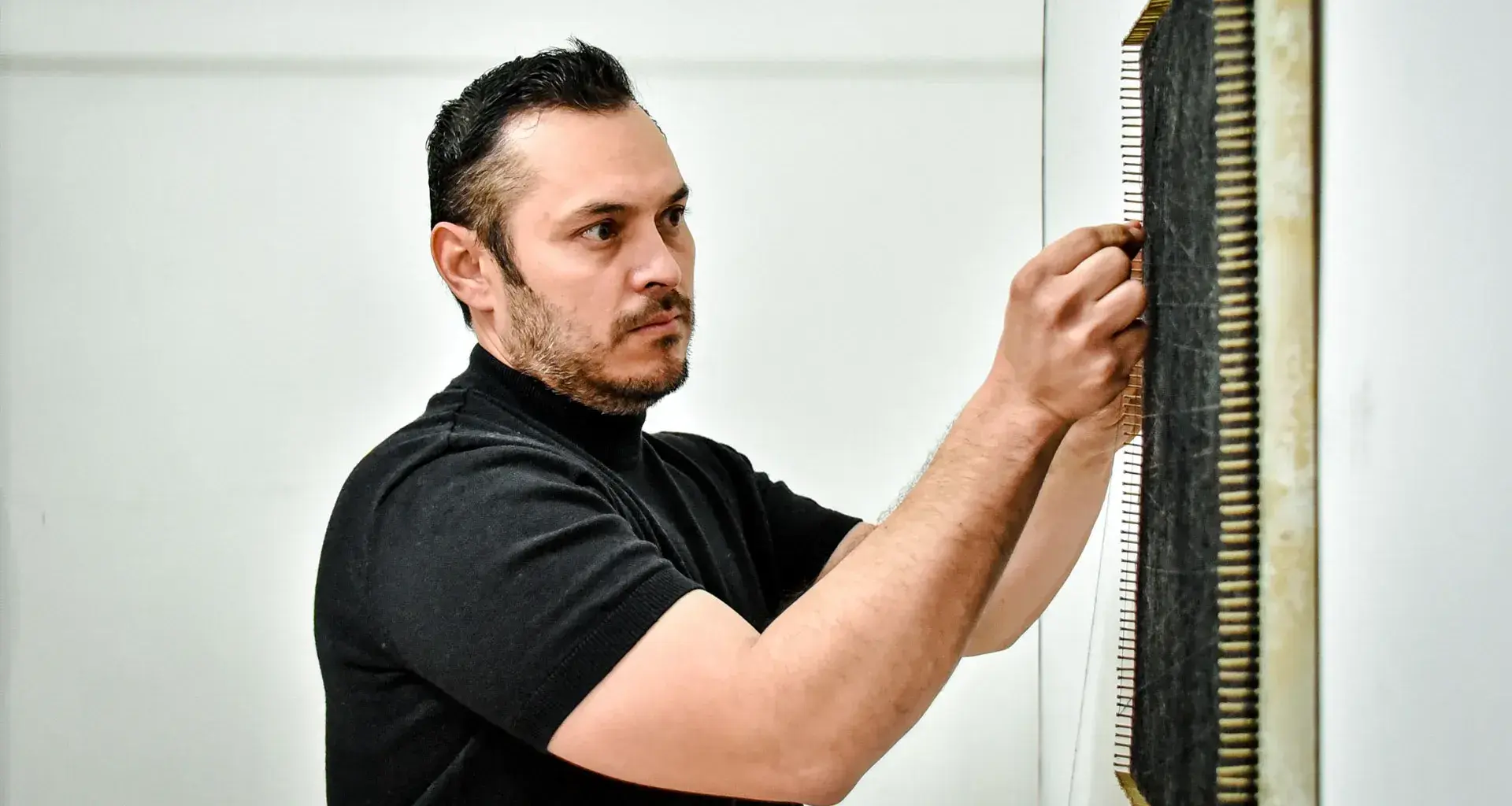“I don’t believe it! Is this for real?!” asked French footballer André-Pierre Gignac in amazement when he saw the effect of the string art that artist Luis Lira had given him.
This artwork is a string design that forms the image of a tiger’s head. When exposed to direct light, it projects a shadow of the player’s face.
Lira, who is also an engineer and Tec de Monterrey employee, has been recognized many times for the originality of his work, and videos of his designs have been seen by hundreds of thousands of social media users.
His role as a string artist began with wanting to prove that Mexicans are capable of creating unique artworks, astonishing celebrities like Vicente Fernández in the process.
As he perfected his style, his own art became his sanctuary in times of difficulty.
(Watch the video in which Luis Lira surprised André-Pierre Gignac)
Wondering if his father was proud of him
Luis inherited an appreciation for the visual arts from his father, a rancher who would draw as a hobby; from him, he learned to draw, paint, and carve wood to make sculptures.
“I liked to watch how easily he would draw pictures; sometimes, he would sit me by his side so I could copy them.
“One day, I made a mural on a wall at home. I thought he was going to get angry when he came home, but he looked at me quietly for a while. Then, instead of scolding me, he gave me advice,” he recalls.
Although he always received love and lessons from his father, Luis would wonder if he was proud of him.
“You always try to be the best at what you do so that your parents are proud; my mom would always tell me that she was proud of me, but my dad didn’t (tell me that).”
Although Lira studied Electronics and Communications Engineering at the UANL, that didn’t mean he forgot his passion for art. On the contrary, he always sought to combine both disciplines.
“The two sides of being an engineer and an artist have made it easy for me to make pieces like these; string art isn’t just the artistic aspect, you have to add a lot of math to it,” he says.
Using the skills he developed during his degree and putting his artistic talent to use, he has created designs with two types of stringing techniques: Hilorama and Hilograma.
The Hilorama technique consists of a wooden board with nails placed throughout the area and strings forming the lines of the image, while an Hilograma is a wooden frame with nails only on the sides and strings that cross from one side to the other to form a design.
“I mastered the Hilorama in months. Each nail is like a pixel on a screen; if you want it to look better, it has to be in large dimensions.
“The Hilograma, like the one I made of Vicente Fernández, took me about 2 years to get right, because it’s more complicated and requires engineering,” he says.
“I dream of my art reaching other places and serving to inspire other people”
When Vicente Fernández thanked him for his artwork
Before gifting Gignac his string art design, Luis had also given designs to other famous people, such as deceased ranchera singer Vicente Fernández.
The singer of “Por tu Maldito Amor” was an artist whom both Luis and his father had always admired.
“I sent the design to Vicente Fernández, and he sent me an audio message saying that he really liked it and there was no doubt in his mind that I was ‘badass,’” Luis recalls with a laugh.
The singer liked the artwork so much that he asked Luis for other pieces for his family and invited him to his ranch.
However, the visit did not take place, as Vicente became ill and eventually passed away. Nevertheless, Luis gave the last of the designs to one of Fernández’s grandchildren.

“I had no doubt: he was very proud of me”
Luis has the satisfaction of having captivated the ranchera artist with his talent, whose thank-you audio message he keeps to this day. He shared it with his father, who had been diagnosed with Parkinson’s.
“Certain things he could no longer do and others he would forget, but when he heard the audio message, I had no doubt: he was very proud of me,” says Luis.
The artist remembers that at that moment he saw a big smile and excitement on his father’s face. Even two weeks later, his father asked him about the singer’s design.
“I was surprised that he remembered; I showed him the design and he smiled again as he looked at it. In the end, he remembered the audio message and said, ‘Vicente Fernández called my son a ‘badass.’"
His art, a sanctuary in times of difficulty
Luis’s father passed away in February of this year, and his mother has been diagnosed with cancer; these have been such hard blows for him that he even lost the will to make art for a time.
“I needed encouragement, motivation, I didn’t want to be in the workshop. But, when Dad died, I had a design to finish and a commitment to deliver it.
“Maybe that helped me keep going; making artwork is tiring, but it also disconnects you from problems. When I finish them, I sit for a few minutes to admire them and enjoy the moment,” he says.
“No way is that artist Mexican”
Lira, who works as an Acoustics and Multimedia specialist at the Tec’s Monterrey campus, remembers showing his colleagues a video of a Mexican artist when he was working on an export platform in Ciudad del Carmen.
This artist painted his work upside down. When he’d finished, he would turn it round to display the final image. Luis expected a different reaction from his colleagues, but they just ridiculed it.
One of them said, “He must be Japanese, European, or Chinese, but no way is he Mexican,” which made him angry and annoyed at the lack of faith in fellow national artists.
From that moment, Luis set himself the goal of changing the minds of those who criticize national talent, recording his work on video to upload them to the Internet.
His first attempt was with the technique he saw in that video, the upside-down painting; even though it took almost a year, his first video went viral when he finished the painting.
“That’s how I started making videos that went viral; that was the goal. In the description, it said that I wanted to prove that Mexicans can do amazing things,” he recalls.
On his social media, he began to receive videos of people doing fascinating things.
“(I received) artworks with different forms, techniques, and styles, such as sand or Rubik’s cube paintings,” he recalls.
So, by rising to these challenges, he added to the list of styles that he could master, demonstrating on his social media that you can do any type of artwork with dedication and practice.
Luis, who hails from Nueva Rosita, Coahuila, has created designs with different techniques and materials such as oils, sand, Rubik’s cubes, light and perspective, and even milk.
“I was doing all those challenges; That’s how one day the Hilorama technique came my way. I received a video of an artist who made a realistic painting with black and white string.”
Seeking again to raise the bar, the Tec collaborator managed to make a realistic string painting, but adding color to make it more vivid.
“The two sides of being an engineer and an artist have made it easy for me to make pieces like these.”

Distinguished for his string art
Luis has been distinguished on different occasions. For example, the La Costeña brand included him in its “100 Mexicans” list along with astronauts, athletes, and other national talents.
Lira met Liga MX Tigres striker Gignac because both had been recognized by a milk brand highlighting their artistic talent; there, he took the opportunity to give Gignac a gift.
“When I found out that Gignac was going to be present, I started working on a special design for him. I completed it in a record time of 10 days; normally it takes 3 weeks. I had several sleepless nights.
“It was very exciting to give him the piece and see his reaction. The guy always amazes us with the way he plays, but this time, I was the one who amazed him. He liked the artwork and said he would put it in a special place in his home,” he recalls.
Seeking to inspire others through art
Today, Luis uploads videos to social media sites such as Facebook, Instagram, and YouTube in which he not only shows thousands of his finished pieces, but also the process behind them.
What’s more, he has managed to place his designs in exhibitions throughout various parts of Mexico and his talent has managed to cross borders by appearing in publications in other countries.
“It gives me a lot of satisfaction to see people’s reactions to my designs, how amazed they are, the reach of my videos, and the feelings they can provoke.
“This is what art is about, evoking emotion in people,” says Luis.
As an engineer and Tec employee, Luis has also taken advantage of his artistic abilities through painting with aspects of lighting, for example.
“Having a studio, I already know what light parameters I should use for color, for example, so that the paintings look the same as those in a museum,” he added.
He works on multimedia, lighting, and acoustic installations in residences on the Querétaro and Monterrey campuses. In the latter, he’s also working at the Wellness Center, Rector’s Building and, soon, in the Expedition building.
“As an artist, I would like Mexican talent to be recognized in other parts of the world; I dream of my art reaching other places and serving to inspire other people,” he concludes.

ALSO READ:





